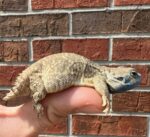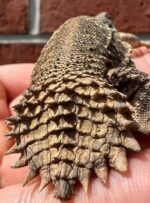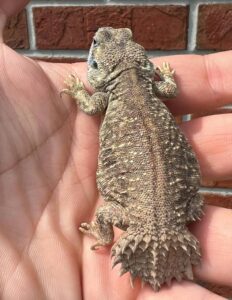Description
The shield-tailed agama (Xenagama taylori), also known commonly as the dwarf shield-tailed agama, Taylor’s strange agama, and the turnip-tailed agama, is a species of lizard in the family Agamidae. The species is endemic to the Horn of Africa.
Etymology of Shield Tailed Agama For Sale
The specific name, taylori, is in honor of British army officer Captain R. H. R. Taylor.
Geographic range of Shield Tailed Agama For Sale
X. taylori is found in eastern Ethiopia and Somalia.
Reproduction
X. taylori is oviparous.
Habitat of Shield Tailed Agama For Sale
X. taylori lives on arid, flat land, sometimes on hilly landscapes, sandy but also hard ground, where it digs deep galleries. It survives at 45 to 50 °C (113 to 122 °F) maximum temperature, but average ranges between 25 and 35 °C (77 and 95 °F) in very dry environments, with the exception of strong spring storms and high humidity.[citation needed]
Description
Adults of X. taylori are less than 10 cm (3.9 in) in total length (including tail), and hatchlings are just over a centimeter (3/8 inch) and weigh only 3 grams (0.11 ounces).[citation needed]
Defensive behavior
Like most other Xenagama species, X. taylori will shelter within self-made burrows and use the whorl-like, heavily built tail to close the burrow to evade predators.
Diet
Being a small lizard, X. taylori is essentially insectivorous, but has been seen to eat grasses, fruits, and berries.
Sexual dimorphism
X. taylori is sexually dimorphic. Sexually mature males display a breeding coloration of vibrant blue on the throat for a short time of the year. Mature males possess larger femoral pores enclosed by a waxy pheromonal yellow substance.
Etymology and taxonomy
In the 10th edition of Systema Naturae of 1758, Linnaeus used the name Agama (pg. 288) as the species Lacerta Agama (with Agama originally capitalized to indicate a name in apposition rather than a Latin adjective, which he would have made lowercase).
His own earlier description from 1749 was derived from Seba, who described and illustrated a number of lizards as Salamandra amphibia and Salamandra Americana, said to resemble in some ways a chameleon lizard and that supposedly came (in error) from “America.” Seba did not use the term “agama”, however. Linnaeus repeated Seba’s error in stating that the lizards lived in the Americas [“habitat in America”], and he included other types of lizards shown and mentioned by Seba under his species name Agama.
Daudin later created the new genus, Agama, to incorporate various African and Asian lizards, as well as species from Mexico, the Caribbean, Central America, and South America. He noted that the name agama was used by inhabitants of Guiana for a species that he included in the genus Agama.
The word “Shield Tailed Agama ” has been traced to West African Gbe languages as a name for the chameleon. The word was brought to Dutch Guiana (modern Suriname) by imported West African slaves and was then used in local creole languages for types of local lizards. Linnaeus may have taken the name “agama” from some unidentified source in the mistaken belief that the reptiles came from the Americas as indicated by Seba.
The name “agama” has no connection to either Greek agamos “unmarried” (as a supposed Latin feminine agama) or to Greek agamai “wonder” as sometimes suggested.
Because of the confusion over the actual taxon that was the basis for the name Shield Tailed Agama , Wagner, et al. (2009) designated a neotype (ZFMK 15222), using a previously described specimen from Cameroon in the collection of the Zoologisches Forschungsmuseum Alexander Koenig in Bonn.

























Reviews
There are no reviews yet.